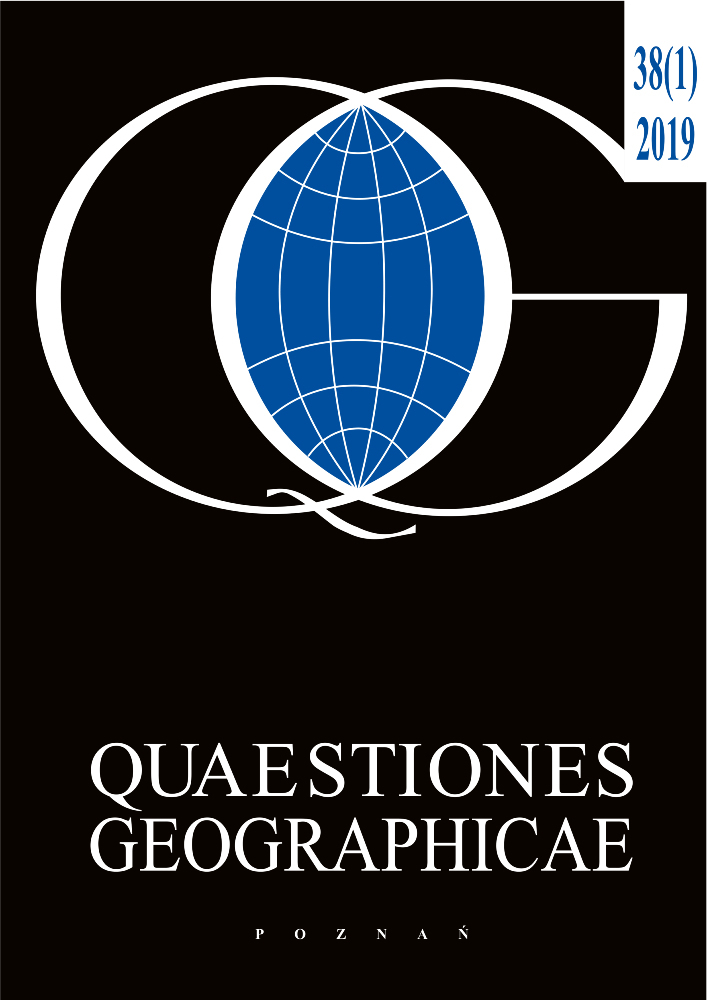Abstract
A systematic investigation has been conducted in several selected geosites in Songkhla Province (Southern Thailand) including inventory, characterization, classification, assessment, and evaluation to study their potentials for geoheritage, geotourism, and geoconservation. A list of geosites have been established for this study, consisting of Songkhla Lagoon/Lake, Samila Beach, Tone Nga Chang (Elephant’s Tusk) Waterfall, Khao Rup Chang (Dragon and Elephant) Cave, and Khao Daeng Hot Spring. Characterization of all these sites have showed that most of the sites have unique and interesting landforms (geomorphological sites), except only a hot spring site (hydrogeological site). The geosites have features of small to large scales (tens meter to larger than 10 km). Qualitative and quantitative assessments have been carried out based on geoheritage values (scientific & educational, aesthetic, recreational, cultural, etc.), with the state/provincial to national levels of significance. Geoconservation efforts should be conducted in all these sites for some purposes, such as research and education as well as geotourism in the province and the region.
References
Brilha J., 2016. Inventory and Quantitative Assessment of Geosites and Geodiversity Sites: a review. Geoheritage 8: 119–134. DOI: 10.1007/s12371-014-0139-3.
Brocx M., Semeniuk V., 2007. Geoheritage and Geoconservation – History, Definition, Scope, and Scale. Journal of the Royal Society of Western Australia 90: 53–80.
Brocx M., Semeniuk V., 2011. Assessing Geoheritage Values: A Case Study Using the Leschenault Peninsula and Its Leeward Estuarine Lagoon, South-western Australia. Proceeding of the Linnean Society of New South Wales 132: 115–130.
Bruno D.E., 2015. Concept of Geosite, In: Tiess G., Majumder T., Cameron T. (eds.), Encyclopedia of Mineral and Energy Policy. Springer: 1–5. DOI: 10.1007/978-3-642-40871-7_6- 1.
DEDE [Department of Alternative Energy Development and Efficiency, Thailand] and CMU [Chiang Mai University], 2006. Potential Assessment of Hot Springs in Thailand, Executive Summary Report, 21 p.
DMR [Department of Minerals Resources], 2007. Geological Map of Songkhla Province. Online: www.dmr.go.th/ewtadmin/ewt/dmr_web/download/pdf/South/Songkla.pdf (accessed 3 June 2016).
DMR [Department of Minerals Resources], 2014. Geology of Thailand. Ministry of Natural Resources and Environment, Bangkok, 508 p.
Dowling R.K., 2013. Global Geotourism – An Emerging Form of Sustainable Tourism. Czech Journal of Tourism 2(2): 59– 79. DOI: 10.2478/cjot-2013-0004.
Gordon J.E., 2012. Rediscovering a Sense of Wonder: Geoheritage, Geotourism and Cultural Landscape Experiences. Geoheritage 4: 65–77. DOI: 10.1007/s12371-011-0051-z.
Gray M., 2004. Geodiversity: Valuing and Conserving Abiotic Nature. John Wiley, Chichester: 434 p.
Gray M., 2005. Geodiversity and Geoconservation: What, Why, and How? The George Wright Forum: 4–12.
GSA [Geological Society of America], 2012. Geoheritage. GSA Position Statement: 56–58.
Henriques M.H., Brilha J., 2017. UNESCO Global Geoparks: a Strategy towards Global Understanding and Sustainability. Episodes 40(4): 349–355.
Henriques M.H., Neto K., 2015. Geoheritage at the Equator: Selected Geosites of São Tomé Island (Cameron Line, Central Africa). Sustainability 7: 648–667. DOI: 10.3390/ su7010648.
Henriques M.H., Pena dos Reis R., Brilha J., Mota, T., 2011. Geoconservation as an Emerging Geoscience. Geoheritage 3(2): 117–128. DOI: 10.1007/s12371-011-0039-8.
Kiernan K., 2015. Landforms as Sacred Places: Implications for Geodiversity and Geoheritage. Geoheritage 7(2): 177– 193. DOI: 10.1007/s12371-014-0128-6.
Komoo I., 2000. Conservation Geology: A Multidisciplinary Approach in Utilization of Earth Resources without Destruction. In: Komoo I., Tjia H.D. (eds), Geological Heritage of Malaysia (Resource Development for Conservation and Nature Tourism). LESTARI UKM, Bangi: 3–11.
Kuttikul P., 2008. Geoheritage of Thailand. In: Leman M.S., Reedman A., Pei C.S. (eds), Geoheritage of East and Southeast Asia. LESTARI UKM and CCOP: 216–249.
Nazaruddin D.A., 2017. Systematic Studies of Geoheritage in Jeli District, Kelantan, Malaysia. Geoheritage 9(1): 19–33. DOI: 10.1007/s12371-015-0173-9.
Newsome D., Dowling R.K., 2005. The Scope and Nature of Geotourism. In: Dowling R.K., Newsome D. (eds), Geotourism. Elsevier: 3–25.
Pena dos Reis R., Henriques M.H., 2009. Approaching an Integrated Qualification and Evaluation System for Geological Heritage. Geoheritage 1(1): 1–10. DOI: 10.1007/ s12371-009-0002-0.
Predrag D., Mirela D., 2010. Inventory of Geoheritage Sites – the Base of Geotourism Development in Montenegro. Geographica Pannonica 14(4): 126–132.
ProGEO [The European Association for the Conservation of the Geological Heritage], 2011. Conserving Our Shared Geoheritage – A Protocol on Geoconservation Principles, Sustainable Site Use, Management, Field Work, Fossil and Mineral Collecting. 10 p. Online: www.progeo.se/progeo-protocol-definitions-20110915.pdf (accessed 30 March 2016).
Pungrassami T., 1983. Geology and Mineral Resources of Songkhla Province, Thailand. Workshop on Stratigraphic Correlation of Thailand and Malaysia: 327–343.
Rahim A., Mustafa R.A., Mohamed B., Ling R.S.J., 2005. Experiencing Cultural Tourism through the Identification of Cultural Routes within the IMT-GT. Forum Proceedings, 3rd Global Summit on Peace through Tourism – Education Forum: 17–26. Satun Geoprak, 2019.
Satun UNESCO Global Park. Online: www.satun-geopark.com/en/ (accessed February 17, 2019).
Sawata H., Trebuil G., Tanchotikul A., Darnsawasdi R., 1983. A Short Note on Geology of the Hadyai –Songkhla Area, Thailand. Workshop on Stratigraphic Correlation of Thailand and Malaysia: 204–212.
Singtuen V., Won-In K., 2018a. Geodiversity and Geoconservation of the Chaiyaphum Region in Thailand for Sustainable Geotourism Planning. GeoJournal of Tourism and Geosites 22(2): 548–560. DOI: 10.30892/gtg.22223-310.
Singtuen V., Won-In K., 2018b. Geological Perspective for Geotourism Development in Uthai Thani Province, Thailand. Journal of Environmental Management and Tourism 9(5): 1003–1010.
Siriphanich S., Palakurthi R., 2006. Factors Affecting Selection of Songkhla Lagoon of Thailand as A Cultural Tourism Destination. Annual of International Thai Tourism Journal: 344–352.
Subtavewung P., Raksaskulwong M., Tulyatid J., 2005. The Characteristic and Classification of Hot Spring in Thailand. Proceedings of World Geothermal Congress 2005, Antalya, Turkey.
TAT [Tourism Authority of Thailand], 2016. Songkhla. Online: www.tourismthailand.org/About-Thailand/Destination/Songkhla (accessed 3 Jun 2016).
Tulyatid D., 2016. Geoconservation and Sustainable Development through Geotourism for the Kanchanaburi Region, Thailand (Abstract). 35th International Geological Congress, Cape Town, South Africa.
Won-In K., Singtuen V., 2018. Geoheritage Conservation for Sustainable Geotourism in Petrified Wood Forest Park, Tak Province, Thailand. The Turkish Online Journal of Design, Art and Communication, Special Edition: 1532–1537.

